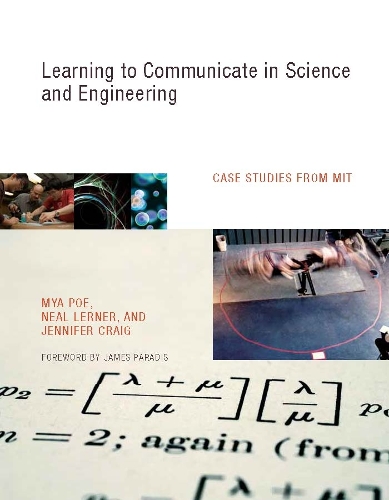
Learning to Communicate in Science and Engineering: Case Studies from MIT
(Hardback)
Publishing Details
Learning to Communicate in Science and Engineering: Case Studies from MIT
By (Author) Mya Poe
By (author) Neal Lerner
By (author) Jennifer Craig
Foreword by James Paradis
MIT Press Ltd
MIT Press
5th February 2010
United States
Classifications
Professional and Scholarly
Non Fiction
Communication studies
501.4
Winner of 2012 Conference on College Composition and Communication (CCCC) Advancement of Knowledge Award 2012
Physical Properties
Hardback
272
Width 178mm, Height 229mm, Spine 11mm
612g
Description
Case studies and pedagogical strategies to help science and engineering students improve their writing and speaking skills while developing professional identities. To many science and engineering students, the task of writing may seem irrelevant to their future professional careers. At MIT, however, students discover that writing about their technical work is important not only in solving real-world problems but also in developing their professional identities. MIT puts into practice the belief that "engineers who don't write well end up working for engineers who do write well," requiring all students to take "communications-intensive" classes in which they learn from MIT faculty and writing instructors how to express their ideas in writing and in presentations. Students are challenged not only to think like professional scientists and engineers but also to communicate like them. This book offers in-depth case studies and pedagogical strategies from a range of science and engineering communication-intensive classes at MIT. It traces the progress of seventeen students from diverse backgrounds in seven classes that span five departments. Undergraduates in biology attempt to turn scientific findings into a research article; graduate students learn to define their research for scientific grant writing; undergraduates in biomedical engineering learn to use data as evidence; and students in aeronautic and astronautic engineering learn to communicate collaboratively. Each case study is introduced by a description of its theoretical and curricular context and an outline of the objectives for the students' activities. The studies describe the on-the-ground realities of working with faculty, staff, and students to achieve communication and course goals, offering lessons that can be easily applied to a wide variety of settings and institutions.
Reviews
"This book goes to the heart of what it means to learn and communicate in the fields of science and engineering. The students and teachers who appear in these cases engage us in the struggle to learn and teach. It's a book full of insights for teachers in STEM fields as well as teachers of technical/scientific communication. And this book's insights are not only for those at elite schools like MIT but anywhere students struggle to make meaning in scientific fields." --David R. Russell, English Department, Iowa State University "At diverse institutions across the country, students are expected to know how to collaborate across differences, whether in engineering, science projects, business, and life. Each chapter of this important book makes a significant contribution to our understanding of how students acquire communicative competence across a range of genres and contexts, how they respond to high-stakes peer review processes typical of the sciences and engineering, and how, as writers, they learn the discipline better through the act of writing." --Terry Myers Zawacki, Director, Writing Across the Curriculum, George Mason University -- Terry Zawacki "A valuable book for teachers and researchers. Through in-depth case studies of MIT's communication-intensive science and engineering courses, Poe, Lerner, and Craig show how the integration of learning to do science and learning to speak, write, and collaborate as professionals is critical in developing future engineers and scientists."--Anne Herrington, Department of English, University of Massachusetts, Amherst -- Anne Herrington "This book is an important contribution to knowledge on the development of scientific writing in engineering. I will definitely cite it in my own work and recommend that graduate students and other researchers and professors read it."--Chris Anson, University Distinguished Professor and Director, Campus Writing and Speaking Program, North Carolina State University -- Chris Anson "A valuable book for teachers and researchers. Through in-depth case studies of MIT's communication-intensive science and engineering courses, Poe, Lerner, and Craig show how the integration of learning to do science and learning to speak, write, and collaborate as professionals is critical in developing future engineers and scientists." Anne Herrington, Department of English, University of Massachusetts, Amherst "At diverse institutions around the country, students are expected to know how to collaborate across differences, whether in engineering, science projects, business, or life. Each chapter of this important book makes a significant contribution to our understanding of how students acquire communicative competence in a range of genres and contexts, how they respond to high-stakes peer review processes typical of the sciences and engineering, and how, as writers, they learn the discipline better through the act of writing." Terry Myers Zawacki, Director, Writing Across the Curriculum, George Mason University "This book is an important contribution to our knowledge about the development of scientific writing in engineering. I will definitely cite it in my own work and recommend that graduate students and other researchers and professors read it." Chris Anson, University Distinguished Professor and Director, Campus Writing and Speaking Program, North Carolina State University
Author Bio
Mya Poe is Director of Technical Communication in MIT's Program in Writing and Humanistic Studies. Neal Lerner is Director of Training in Communication Instruction in MIT's Program in Writing and Humanistic Studies. Jennifer Craig is Lecturer in Writing Across the Curriculum in MIT's Program in Writing and Humanistic Studies. James Paradis is Professor and Head of the Program in Writing and Humanistic Studies at the Massachusetts Institute of Technology.
